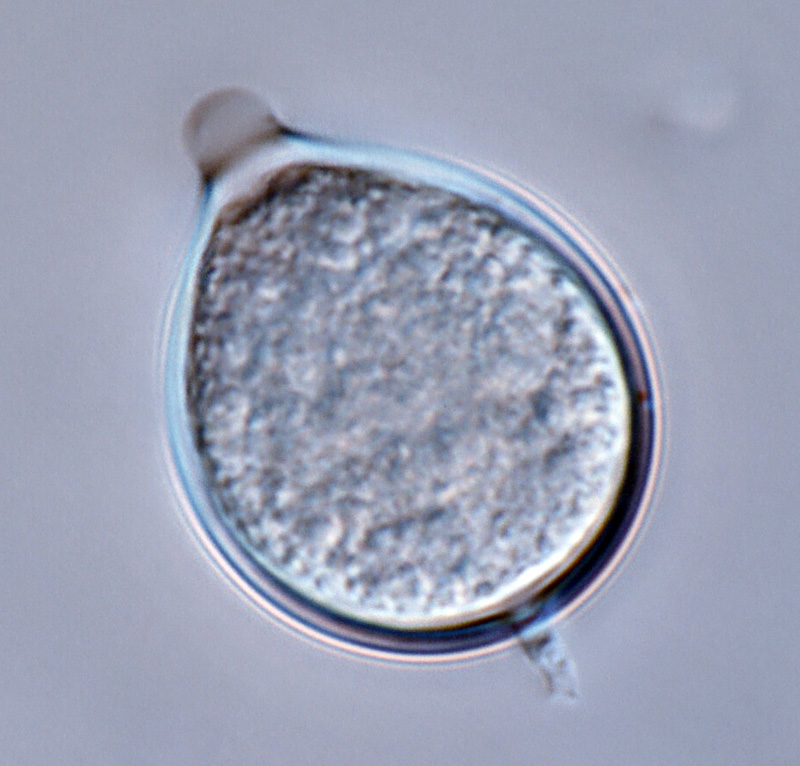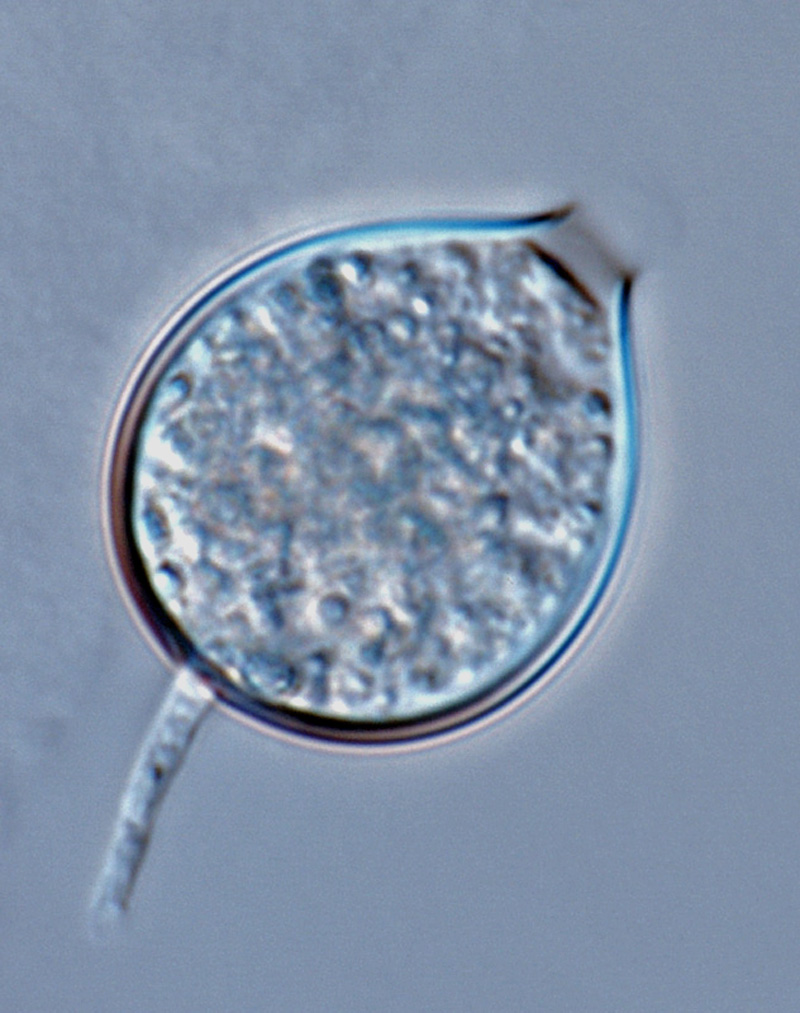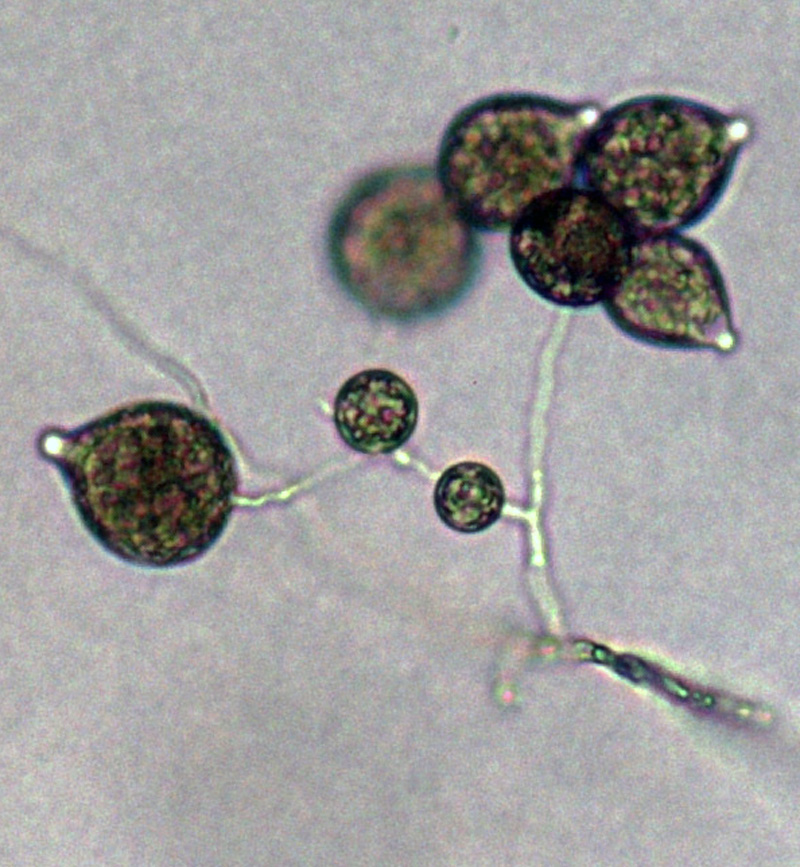Phytophthora megakarya (in progress - Abad et al. 2023b)
|
Phytophthora spp. in Clade 4: portion of the seven-loci ML phylogeny featuring the type cultures of 212 described species (by T. Bourret). Notice the position of P. megakarya selected specimen CBS 238.83 = S&T BL 73. Gloria Abad, USDA S&T.
|
|
Phytophthora spp. in Clade 4: Morphological Tabular key (PDF) and Tabular key legends (PDF) in IDphy2 KEY SECTION. Notice the data of P. megakarya selected specimen CBS 238.83 = S&T BL 73. Gloria Abad, USDA S&T.
|
|
Phytophthora megakarya (CPHST BL 22) colonies of the selected specimen grown for 7 days on (a) V8®Agar, (b) potato dextrose agar, and (c) malt extract agar; photo by Krysta Jennings and Leandra Knight, USDA-APHIS-PPQ |
|
Phytophthora megakarya (CPHST BL 73) colonies of the selected specimen grown for 7 days on (a) V8 Agar, (b) potato dextrose agar, and (c) malt extract agar; photo by Clinton Greub, Krysta Jennings, and Leandra Knight, USDA-APHIS-PPQ |
|
P. megakarya (selected specimen P8516) collected from Theobroma cacao in Sao Tome and Principe (Gulf of Guinea): (a–c) sporangia globose to ovoid, papillated, caducous with medium pedicels; (d, e) ovoid-globose sporangia borne in close sympodial sporangiophores formed on V8 agar flooded with (10%) soil extract; scale bar = 10 µm; photos by Gloria Abad, USDA-APHIS-PPQ. |
|
P. megakarya (selected specimen P8516) collected from Theobroma cacao in Sao Tome and Principe (Gulf of Guinea): sporangia globose to ovoid, papillated, caducous with medium pedicel; photo by Gloria Abad, USDA-APHIS-PPQ. |
|
P. megakarya (selected specimen P8516) collected from Theobroma cacao in Sao Tome and Principe (Gulf of Guinea): sporangia globose to ovoid, papillated, caducous with medium pedicel; photo by Gloria Abad, USDA-APHIS-PPQ. |
|
P. megakarya (selected specimen P8516) collected from Theobroma cacao in Sao Tome and Principe (Gulf of Guinea): sporangia globose to ovoid, papillated, caducous with medium pedicel; photo by Gloria Abad, USDA-APHIS-PPQ. |
|
P. megakarya (selected specimen P8516) collected from Theobroma cacao in Sao Tome and Principe (Gulf of Guinea): ovoid-globose sporangia borne in close sympodial sporangiophores formed on V8 agar flooded with (10%) soil extract; photo by Gloria Abad, USDA-APHIS-PPQ. |
|
P. megakarya (selected specimen P8516) collected from Theobroma cacao in Sao Tome and Principe (Gulf of Guinea): ovoid-globose sporangia borne in close sympodial sporangiophores formed on V8 agar flooded with (10%) soil extract; photo by Gloria Abad, USDA-APHIS-PPQ. |
Name and publication
Phytophthora megakarya Brasier & Griffin (1979)
Phytophthora megakarya Brasier & M.J. Griffin ex Abad sp. nov. (2023)
Brasier CM and Griffin MJ. 1979. Taxonomy of 'Phytophthora palmivora' on cocoa. T. Brit. Mycol. Soc. 72: 111–143 (pg. 137).
Phytophthora L-type (Brasier and Griffin, 1979)
Nomenclature
from Brasier and Griffin 1979
Mycobank
Typification
Type: NIGERIA collected from cocoa (Theobroma cacao L.) IMI 182590 A1, and CAMEROON collected from cocoa (Theobroma cacao L.) IMI 202077, A2 (original publication cites two types)
Nomenclature under revision.
Well-authenticated specimen(s) selected by Gloria Abad:
Selected specimen #1: CPHST BL 22 = P1664 (WPC) = IMI 182590: NIGERIA, P38, A1, L, lfusk, Ibadan
Selected specimen #2: CPHST BL 73 = P1672 (WPC) = IMI 202077: CAMEROON, P184, A2, L, ex B. Boccas, no. 36
Selected specimen(s) in other collections
(SE) CBS 238.83 (A2), NRRL 64259, ATCC 42100 (MCI), CABI IMI202077 (AVA), P184, WPC P1672, S&T BL 73 (Abad), 61J5 (Hong)
Molecular identification
Voucher sequences for barcoding genes (ITS rDNA and COI) of the selected specimen (see Molecular protocols page)
Phytophthora megakarya isolate CPHST BL 22 (= P1664 WPC) = ITS rDNA MG865533, COI MH136928
Phytophthora megakarya isolate CPHST BL 73 (= P1672 WPC) = ITS rDNA MG865534, COI MH136929
Voucher sequences for Molecular Toolbox with seven genes (ITS, β-tub, COI, EF1α, HSP90, L10, and YPT1
(see Molecular protocols page) (In Progress)
Voucher sequences for Metabarcoding High-throughput Sequencing (HTS) Technologies [Molecular Operational Taxonomic Unit (MOTU)]
(see Molecular protocols page) (In Progress)
Sequences with multiple genes for selected specimen in other sources
- NCBI: Phytophthora megakarya CPHST BL 22
- NCBI: Phytophthora megakarya P1664
- EPPO-Q-bank: Phytophthora megakarya
- BOLDSYSTEMS: Phytophthora megakarya (barcoding COI & ITS)
Sequences for specimen #2 in other sources
- NCBI: Phytophthora megakarya CPHST BL 73
- NCBI: Phytophthora megakarya P1672
- NCBI: Phytophthora megakarya CBS 238.83
- EPPO-Q-bank: Phytophthora megakarya CBS 238.83
- BOLDSYSTEMS: Phytophthora megakarya (barcoding COI & ITS)
Position in multigenic phylogeny with 7 genes (ITS, β-tub, COI, EF1α, HSP90, L10, and YPT1)
Clade 4
Morphological identification
Colonies and cardinal temperatures
Colony colony:
assemblage of hyphae which usually develops form a single source and grows in a coordinated way
morphology after 7 days of growth on V8 agar and malt extract agar with light chrysanthemum pattern, on potato dextrose agar with no distinct pattern. Minimum temperature for growth is 10°C, optimum 24–26°C, and maximum 30°C.
Conditions for growth and sporulation
Sporangia produced on V-8 agar flooded with 10% soil solution.
Asexual phase
SporangiaSporangia:
sac within which zoospores form, especially when water is cooled to about 10°C below ambient temperature; in solid substrates, sporangia usually germinate by germ tubes
papillatepapillate:
pertaining to the production of a distinct papilla at the distal end of the sporangium (cf. nonpapillate and semipapillate)
(frequently with one papillaepapillae:
a small rounded or conic protuberance, generally translucent, on the wall of sporangia that breaks open and serves as the exit-point of zoospores
, rarely 2 or 3); caducouscaducous:
pertaining to sporangia that become dislodged readily (i.e. deciduous) and separate from the sporangiophore (cf. persistent)
with medium pedicelpedicel:
the hyphal base of a sporangium that remains attached after the sporangium separates, or is shed, from the sporangiophore; the pedicel may be short (< 5 µm), medium (5–20 µm), or long (> 20 µm)
(10–30 µm); frequently obpyriformobpyriform:
inversely pear-shaped, i.e. with the widest part at the point of attachment (cf. pyriform)
with well-rounded bases, sometimes globoseglobose:
having a rounded form resembling that of a sphere
, ovoidovoid:
egg-shaped, with the widest part at the base of the sporangium and the narrow part at the apex
or elongate-ovoid, or ellipsoidellipsoid:
refers to a solid body that forms an ellipse in the longitudinal plane and a circle in cross section; many fungal spores are ellipsoidal or elliptic
(20–60 x 13-41 μm). SporangiaSporangia:
sac within which zoospores form, especially when water is cooled to about 10°C below ambient temperature; in solid substrates, sporangia usually germinate by germ tubes
originated in loose sympodial sporangiophores. Hyphal swellings absent. ChlamydosporesChlamydospores:
an asexual spore with a thickened inner wall that is delimited from the mycelium by a septum; may be terminal or intercalary, and survives for long periods in soil
are very rare, but occur both in agar as well as in water cultures and are mostly terminal (20–44 μm diam).
Heterothallic. OogoniaOogonia:
the female gametangium in which the oospore forms after fertilization by the antheridium
smooth (19–37 μm diam), antheridiaantheridia:
the male gametangium; a multinucleate, swollen hyphal tip affixed firmly to the wall of the female gametangium (the oogonium)
amphigynousamphigynous:
pertaining to the sexual stage in which the antheridium completely surrounds the stalk of the oogonium (cf. paragynous)
, situated either well down the oogonial stalk or high up as a collar, depending on the degree of taper of the oogoniumoogonium:
the female gametangium in which the oospore forms after fertilization by the antheridium
(10–16 μm); oosporesoospores:
zygote or thick-walled spore that forms within the oogonium after fertilization by the antheridium; may be long-lived
pleroticplerotic:
pertaining to an oospore that fills the oogonium (cf. aplerotic)
(18–34 μm diam).
Most typical characters
Phytophthora megakarya is characterized by the shape of the caducouscaducous:
pertaining to sporangia that become dislodged readily (i.e. deciduous) and separate from the sporangiophore (cf. persistent)
, globoseglobose:
having a rounded form resembling that of a sphere
to ovoidovoid:
egg-shaped, with the widest part at the base of the sporangium and the narrow part at the apex
sporangia with medium pedicelpedicel:
the hyphal base of a sporangium that remains attached after the sporangium separates, or is shed, from the sporangiophore; the pedicel may be short (< 5 µm), medium (5–20 µm), or long (> 20 µm)
and produced in loose sympodial sporangiophores, and also by the shape of the sexual stage.
Specimens evaluated
Specimen #1: Phytophthora megakarya CPHST BL 22 = P1664 (World Phytophthora Collection)
Specimen #2: Phytophthora megakarya CPHST BL 73 = P1672 (World Phytophthora Collection)
Phytophthora megakarya P8516 (World Phytophthora Collection)
Hosts and distribution
Distribution: Africa (Nigeria, Cameroon, Ghana, Fernando Po) (Erwin & Ribeiro 1996)
Substrate: pods, seedlings, bark of trunks, possibly roots
Disease note: pod rot, seedling blight, trunk canker. Inoculum does not survive in mummified pods, but survives in soil up to 18 months, possibly in infected roots (Erwin & Ribeiro 1996).
Host: Theobroma cacao (cacao, Sterculiaceae); also reported from Irvingia sp. (Irvingiaceae)
Retrieved January 31, 2018 from U.S. National Fungus Collections Nomenclature Database.
Additional info
Substrate: foliage, fruits, root
Quarantine status
USA: This species was listed as a species of concern during the 2009 Phytophthora prioritization project conducted by USDA APHIS PPQ CPHST PERAL (Schwartzburg et al.).
Additional references and links
- SMML USDA-ARS: Phytophthora megakarya
- EPPO Global Database: Phytophthora megakarya
- Forest Phytophthoras of the world: Phytophthora megakarya
- CABI Digital Library: Phytophthora megakarya
- Encyclopedia of Life (EOL): Phytophthora megakarya
- Index Fungorum (IF): Phytophthora megakarya
- Google All Phytophthora megakarya
- Google Images Phytophthora megakarya
- Google Scholar Phytophthora megakarya
Fact sheet author
Z. Gloria Abad, Ph.D., USDA-APHIS-PPQ-S&T Plant Pathogen Confirmatory Diagnostics Laboratory (PPCDL), United States of America.








